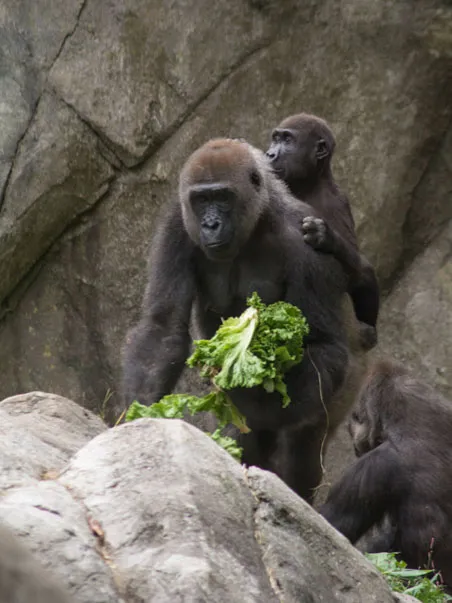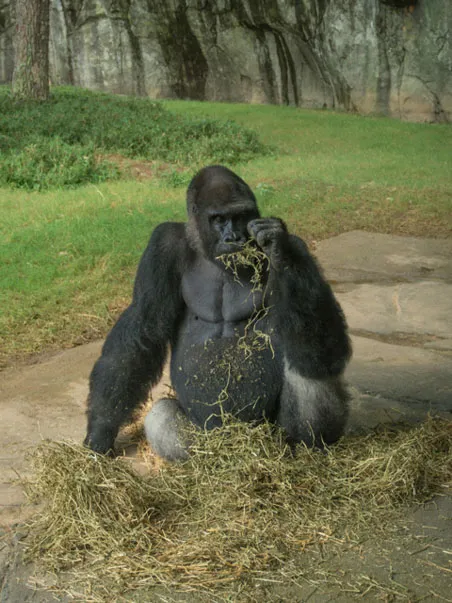Written by Emily Lynch, Ph.D., Associate Curator of Research, North Carolina Zoo
When you start to put on a little weight, what’s one of the first things you look to change? Your diet, right?
It is fairly common wisdom that simple sugars, found in most processed carbohydrate foods, candy, and sodas, are associated with weight gain and obesity. It is also pretty well known that obesity is linked to a myriad of health problems, including heart disease.
The same connections between diet and health are true for other animals, as well. A good example of this can be seen in one of the perennial visitor favorites at the Zoo, the gorillas. While gorillas generally thrive in zoos, a worrying trend emerged a few years ago. When heart disease began to be identified as one of the main causes of death among older zoo gorillas (see my previous blog on how this is being addressed on a clinical level), diet was one of the first considerations when searching for a solution.
In the wild, gorillas typically spend their day consuming large quantities of herbaceous vegetation, a food source which is high in fiber and low in caloric density (see my previous blog on gorilla food enrichment). Zoo-housed gorillas, on the other hand, are frequently given a diet that is higher in calories and lower in fiber than what they would eat in the wild. These diets also contain commercially produced biscuits (“monkey chow”), which are calorically dense and high in simple carbohydrates and grain-based. The goal of adding these scientifically formulated biscuits to gorillas’ diets is to ensure they are getting all the nutrients they need. However, Zoo staff began to wonder whether they may be having negative effects as well.
Dr. Richard Bergl, Director of Conservation, Education, and Science at the North Carolina Zoo, set out to investigate whether the diet traditionally fed to gorillas in zoos might be contributing to their health problems. In order to do this he set out to see if he could create a new diet that not only closely mimicked that of wild gorillas, but also reduced weight gain and ultimately ameliorated associated health problems, including cardiac disease. In order to quantitatively measure the effects of new diet, Dr. Bergl turned to scientific research.

Picture 1: Olympia carrying her prized green leaf lettuce bunch with her baby, Apollo on her back
First, Dr. Bergl was challenged to create a novel diet for the North Carolina Zoo’s gorillas that mirrored the foods consumed by their wild counterparts, was low in calories, high in fiber, limited fruit and starchy vegetables, all the while meeting their nutritional needs. This was not as easy as you might think! Dr. Bergl told me this took lots of playing around with different food items; notably, just because you give the gorillas a perfect food, it does not mean they will eat it. For example, spinach and kale were great substitutions for the monkey chow and fruit which were higher in sugar, but the gorilla’s refused to eat them. Eventually, Dr. Bergl landed on a combination of vegetables, leafy greens, alfalfa hay, and a small amount of fruit, accompanied by a multi-vitamin.

Picture 2: Apollo enjoying a core head of romaine lettuce for a snack
Changes to cardiovascular health can take years to accrue, so in order to investigate whether the new diet was having an impact in a shorter period of time, Dr. Bergl conducted a study of both behavioral measures and the gorillas’ blood chemistry. Zookeepers and research staff observed the gorillas’ behavior over a period of months to see if it changed on the new diet and Zoo vets collected blood samples during physical exams which were sent to the lab for analysis. The gorillas were also weighed regularly to make sure they weren’t gaining or losing too much weight.
The behavioral research showed that the gorillas were twice as active after the switch to the new diet, with a lot more time spent processing and consuming food. This was a good sign, since in the wild gorillas spend most of their waking hours looking for food. Along with increased activity, the gorillas all maintained a healthy weight, despite eating a diet much lower in fruit and without any monkey chow. The lab results further confirmed the benefits of the new diet, with indicators of obesity and inflammation all reduced. In the end, Dr. Bergl found that the Zoo was able to feed the gorillas a low calorie, high fiber diet, which kept them physically engaged, increasing their daily active foraging time, as well as maintaining or improving body condition.

Picture 3: Mosuba, our silverback, feasting on alfalfa hay
Now our gorillas are eating a diet that provides them with all their nutritional needs, without relying on excessive fruit or monkey chow. They particularly enjoy romaine lettuce (Pictures 1 and 2) and alfalfa hay (Picture 3). While this might pose some new challenges (a new, giant walk in fridge was required to accommodate the large volume of leafy greens now being consumed on a daily basis), our gorillas are now living happier, healthier lives.
Indeed, the new gorilla diet has a lot of a-peel!





